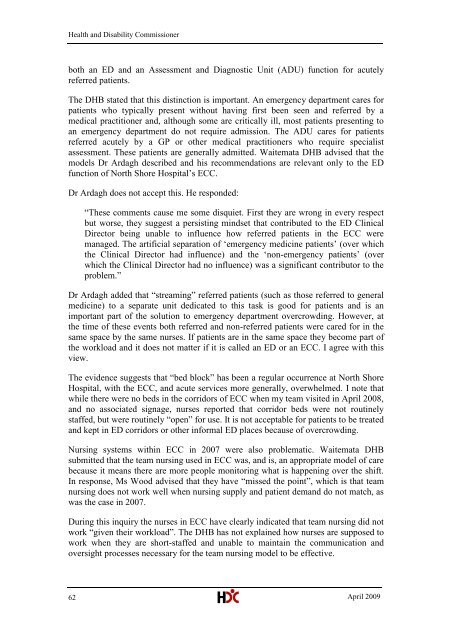North Shore Hospital report - New Zealand Doctor
North Shore Hospital report - New Zealand Doctor
North Shore Hospital report - New Zealand Doctor
You also want an ePaper? Increase the reach of your titles
YUMPU automatically turns print PDFs into web optimized ePapers that Google loves.
Health and Disability Commissionerboth an ED and an Assessment and Diagnostic Unit (ADU) function for acutelyreferred patients.The DHB stated that this distinction is important. An emergency department cares forpatients who typically present without having first been seen and referred by amedical practitioner and, although some are critically ill, most patients presenting toan emergency department do not require admission. The ADU cares for patientsreferred acutely by a GP or other medical practitioners who require specialistassessment. These patients are generally admitted. Waitemata DHB advised that themodels Dr Ardagh described and his recommendations are relevant only to the EDfunction of <strong>North</strong> <strong>Shore</strong> <strong>Hospital</strong>‘s ECC.Dr Ardagh does not accept this. He responded:―These comments cause me some disquiet. First they are wrong in every respectbut worse, they suggest a persisting mindset that contributed to the ED ClinicalDirector being unable to influence how referred patients in the ECC weremanaged. The artificial separation of ‗emergency medicine patients‘ (over whichthe Clinical Director had influence) and the ‗non-emergency patients‘ (overwhich the Clinical Director had no influence) was a significant contributor to theproblem.‖Dr Ardagh added that ―streaming‖ referred patients (such as those referred to generalmedicine) to a separate unit dedicated to this task is good for patients and is animportant part of the solution to emergency department overcrowding. However, atthe time of these events both referred and non-referred patients were cared for in thesame space by the same nurses. If patients are in the same space they become part ofthe workload and it does not matter if it is called an ED or an ECC. I agree with thisview.The evidence suggests that ―bed block‖ has been a regular occurrence at <strong>North</strong> <strong>Shore</strong><strong>Hospital</strong>, with the ECC, and acute services more generally, overwhelmed. I note thatwhile there were no beds in the corridors of ECC when my team visited in April 2008,and no associated signage, nurses <strong>report</strong>ed that corridor beds were not routinelystaffed, but were routinely ―open‖ for use. It is not acceptable for patients to be treatedand kept in ED corridors or other informal ED places because of overcrowding.Nursing systems within ECC in 2007 were also problematic. Waitemata DHBsubmitted that the team nursing used in ECC was, and is, an appropriate model of carebecause it means there are more people monitoring what is happening over the shift.In response, Ms Wood advised that they have ―missed the point‖, which is that teamnursing does not work well when nursing supply and patient demand do not match, aswas the case in 2007.During this inquiry the nurses in ECC have clearly indicated that team nursing did notwork ―given their workload‖. The DHB has not explained how nurses are supposed towork when they are short-staffed and unable to maintain the communication andoversight processes necessary for the team nursing model to be effective.62April 2009
















